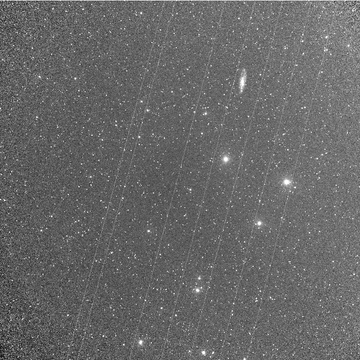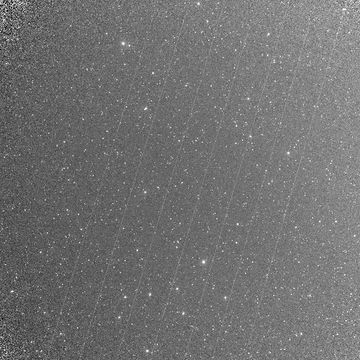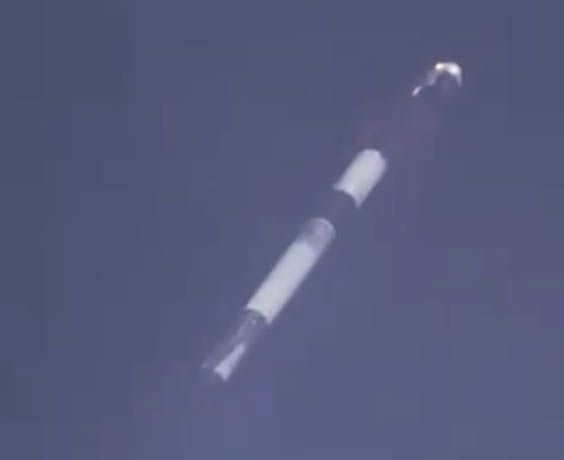You are using an out of date browser. It may not display this or other websites correctly.
You should upgrade or use an alternative browser.
You should upgrade or use an alternative browser.
SpaceX (general discussion)
- Thread starter FutureSpaceTourist
- Start date
- Joined
- 21 January 2015
- Messages
- 12,156
- Reaction score
- 16,372
The astronomer royal in the UK Martin Rees has now weighed in on the topic of satellite constellations like Starlink. He does attempt to be even handed in his comments.

 amp.theguardian.com
amp.theguardian.com

Be wary of Elon Musk despoiling the ‘vault of heaven’ | Martin Rees
It’s feasible to flood space with flotillas of small satellites – but do we really want to?
- Joined
- 21 January 2015
- Messages
- 12,156
- Reaction score
- 16,372
- Joined
- 21 January 2015
- Messages
- 12,156
- Reaction score
- 16,372
A launch planned for Friday from the Space Coast will test a possible solution. SpaceX will experiment with a non-reflective coating on the bottom of one satellite in its next batch of 60, scheduled to lift off from launch complex 40 at Cape Canaveral Air Force Station at 11:20 p.m.

Astronomers say SpaceX's satellites are too bright in the sky. Friday's launch will try to fix that
They were seen sparkling across the skies of Montana right around Christmas: a tidy row of lights that some mistook to be UFOs. The glowing celestial train has been spotted in California, Texas, in the Netherlands and even Chile.
phys.org
FighterJock
ACCESS: Above Top Secret
- Joined
- 29 October 2007
- Messages
- 5,609
- Reaction score
- 5,941
A launch planned for Friday from the Space Coast will test a possible solution. SpaceX will experiment with a non-reflective coating on the bottom of one satellite in its next batch of 60, scheduled to lift off from launch complex 40 at Cape Canaveral Air Force Station at 11:20 p.m.

Astronomers say SpaceX's satellites are too bright in the sky. Friday's launch will try to fix that
They were seen sparkling across the skies of Montana right around Christmas: a tidy row of lights that some mistook to be UFOs. The glowing celestial train has been spotted in California, Texas, in the Netherlands and even Chile.phys.org
I hope that the experimental coating works on the satellite, it is a pity that they couldn't put it on the first lot of satellites before they reached orbit
- Joined
- 3 June 2011
- Messages
- 18,339
- Reaction score
- 12,242
It's a pity SpaceX wasn't flying rockets in 1950.A launch planned for Friday from the Space Coast will test a possible solution. SpaceX will experiment with a non-reflective coating on the bottom of one satellite in its next batch of 60, scheduled to lift off from launch complex 40 at Cape Canaveral Air Force Station at 11:20 p.m.

Astronomers say SpaceX's satellites are too bright in the sky. Friday's launch will try to fix that
They were seen sparkling across the skies of Montana right around Christmas: a tidy row of lights that some mistook to be UFOs. The glowing celestial train has been spotted in California, Texas, in the Netherlands and even Chile.phys.org
I hope that the experimental coating works on the satellite, it is a pity that they couldn't put it on the first lot of satellites before they reached orbit
FighterJock
ACCESS: Above Top Secret
- Joined
- 29 October 2007
- Messages
- 5,609
- Reaction score
- 5,941
SpaceX has launched more Starlink satellites into space.
https://www.bbc.co.uk/news/science-environment-51013308
https://www.bbc.co.uk/news/science-environment-51013308
- Joined
- 21 January 2015
- Messages
- 12,156
- Reaction score
- 16,372
- Joined
- 21 January 2015
- Messages
- 12,156
- Reaction score
- 16,372
- Joined
- 21 January 2015
- Messages
- 12,156
- Reaction score
- 16,372
Hall and other astronomers said that, like SpaceX, they were surprised by how bright the Starlink satellites appeared. “What surprised everyone — the astronomy community and SpaceX — was how bright their satellites are,” Seitzer said. “We knew these tens of thousands of megaconstellations were coming, but based on the sizes and shapes of things currently in orbit, I thought they’d be maybe eighth or ninth magnitude. We were not expecting second or third magnitude.”
Both astronomers and SpaceX said they hope, as an initial step to get the Starlink satellites dim enough to not be visible to the naked eye even in the darkest skies. The next step will be to figure out what else can be done to mitigate their effects on major observatories, specifically the Vera Rubin Observatory (formerly Large Synoptic Survey Telescope) under construction in Chile. Astronomers said that wide-field telescope was particularly threatened by Starlink and other megaconstellation satellites.

SpaceX, astronomers working to address brightness of Starlink satellites
SpaceX says it’s committed to working with the astronomy community to address the brightness of its Starlink satellites, but some astronomers remain concerned about the deleterious effect that syst…
 spacenews.com
spacenews.com
Overpressure test of Starship tank. No info yet on what level damage occurred. Nasa Spaceflight refers to test as "successful" so implication is tank was tested to destruction.
Update: Failed at 7.1 Bar. 6 Bar needed for pressure and 1.4x safety factor (8.5 Bar) needed for man rating. Cause of failure located and design upgrades will be implemented to fix.
Update: Failed at 7.1 Bar. 6 Bar needed for pressure and 1.4x safety factor (8.5 Bar) needed for man rating. Cause of failure located and design upgrades will be implemented to fix.
Last edited:
- Joined
- 9 October 2009
- Messages
- 21,976
- Reaction score
- 13,638

Yusaku Maezawa: Japanese billionaire seeks 'life partner' for Moon voyage
Yusaku Maezawa appeals for a "life partner" to join him on Space X's maiden Moon voyage in 2023.
- Joined
- 21 January 2015
- Messages
- 12,156
- Reaction score
- 16,372
- Joined
- 21 January 2015
- Messages
- 12,156
- Reaction score
- 16,372
jeffb
ACCESS: Top Secret
- Joined
- 7 October 2012
- Messages
- 1,281
- Reaction score
- 1,939
ASAS-SN
@SuperASASSN
All-Sky Automated Survey for SuperNovae All Sky, All the Time - Global Network of Robotic Telescopes ASAS-SN, but also astro/OSU/other - follow at your own risk
2xChile, Hawaii, South Africa, Texasastronomy.ohio-state.edu/asassn/
Joined June 2013
71 Following
4,431 Followers

ASAS-SN
@SuperASASSN
We hate you, #Starlink
#Starlinked


- Joined
- 21 January 2015
- Messages
- 12,156
- Reaction score
- 16,372
- Joined
- 13 August 2007
- Messages
- 8,451
- Reaction score
- 11,024
in series of Tweets Musk announced
that Starship will be launch 3 flights/day avg rate, so ~1000 flights/year, and will have Fleet of 100 Superheavy/Starship
a forest of launch towers
Dragon029
ACCESS: Top Secret
- Joined
- 17 March 2009
- Messages
- 881
- Reaction score
- 440
Do keep in mind that a design goal and what will realistically happen are two different things - funding 10,000 launches a year (even if the 'stuff' you're sending and the launch cost combined is something like $10 million a launch, for $100 billion a year), will be challenging without a very pressing objective. I consider myself optimistic about human colonisation of Mars, but I think it's going to be a fair bit slower than Elon hopes.
- Joined
- 3 June 2011
- Messages
- 18,339
- Reaction score
- 12,242
Do keep in mind that a design goal and what will realistically happen are two different things - funding 10,000 launches a year (even if the 'stuff' you're sending and the launch cost combined is something like $10 million a launch, for $100 billion a year), will be challenging without a very pressing objective. I consider myself optimistic about human colonisation of Mars, but I think it's going to be a fair bit slower than Elon hopes.
Aim high.
Full video resume of Last test flight:

 www.space.com
www.space.com

SpaceX's Crew Dragon abort test was 'picture-perfect,' Elon Musk says
Crew Dragon could carry astronauts for the first time in just a few months.
Last edited:
- Joined
- 21 January 2015
- Messages
- 12,156
- Reaction score
- 16,372
- Joined
- 9 October 2009
- Messages
- 21,976
- Reaction score
- 13,638

SpaceX presses on with legal fight against U.S. Air Force over rocket contracts
SpaceX has asked the U.S. District Court of the Central District of California to hold a hearing on March 2 to consider the company’s protest against the U.S. Air Force.
 spacenews.com
spacenews.com
- Joined
- 21 January 2015
- Messages
- 12,156
- Reaction score
- 16,372
I’d love to know the thinking that says Space X are a more risky prospect when one has established launchers to space and one doesn’t. They seem to have used the fact that Starship is a risky project to penalise them across the board.
SpaceX presses on with legal fight against U.S. Air Force over rocket contracts
SpaceX has asked the U.S. District Court of the Central District of California to hold a hearing on March 2 to consider the company’s protest against the U.S. Air Force.spacenews.com
- Joined
- 9 October 2009
- Messages
- 21,976
- Reaction score
- 13,638
- Joined
- 21 January 2015
- Messages
- 12,156
- Reaction score
- 16,372
Dilandu
I'm dissatisfied, which means, I exist.
More from Hazegrayart. Starship moon landing. Shows it using a prepared but pretty small landing pad.
IMHO the moon-equipped variant would require a special landing legs...
More from Hazegrayart. Starship moon landing. Shows it using a prepared but pretty small landing pad.
IMHO the moon-equipped variant would require a special landing legs...
Interesting question. I assume both Spacex and Blue Origin landing legs have some small amount of travel to cushion landing shock but maybe not. Depends on how accurately you can control terminal descent velocity. I think the crush absorbers on Falcon 9 are there because of the unpredictable pitch/roll motion of the landing barge.
Dilandu
I'm dissatisfied, which means, I exist.
Interesting question. I assume both Spacex and Blue Origin landing legs have some small amount of travel to cushion landing shock but maybe not. Depends on how accurately you can control terminal descent velocity. I think the crush absorbers on Falcon 9 are there because of the unpredictable pitch/roll motion of the landing barge.
Well, personally, I would use the detachable set of landing legs specifically for Moon conditions, which then the rocket would just left. Yes, it would probably hamper payload a bit, but Starship seems to be the rocket that could afford it.
P.S. Of course, it all depend on how well the landing pad is prepared. If it is cleared, smoothed and paved, then the Earth landing legs should suffice.
Given the relaxed gravity on the moon, they could probably afford a lean down maneuver with only a set of aft legs touching the ground at the end of the boosted recovery and a pair of mini diabolo in the front (see the little guy below).
That would probably save a substantial amount of space, fuel and payload with also the cargo bay at reach at a lower height while Starship seat horizontally on the ground.
Then, once empty, just pitch-up (Vernier/Draco or mechanical impulse) and go.
Ex :

That would probably save a substantial amount of space, fuel and payload with also the cargo bay at reach at a lower height while Starship seat horizontally on the ground.
Then, once empty, just pitch-up (Vernier/Draco or mechanical impulse) and go.
Ex :

Last edited:
Well they caught at least one of the fairing halves.
- Joined
- 3 June 2011
- Messages
- 18,339
- Reaction score
- 12,242
Is that what they were shooting for?8.5 Barr achieved.
Similar threads
-
-
-
-
McDonnell Douglas X-33 SSTO Reusable Launch Vehicle
- Started by athpilot
- Replies: 0
-
Breitbart, other conservative outlets escalate anti-SpaceX campaign
- Started by Flyaway
- Replies: 5
